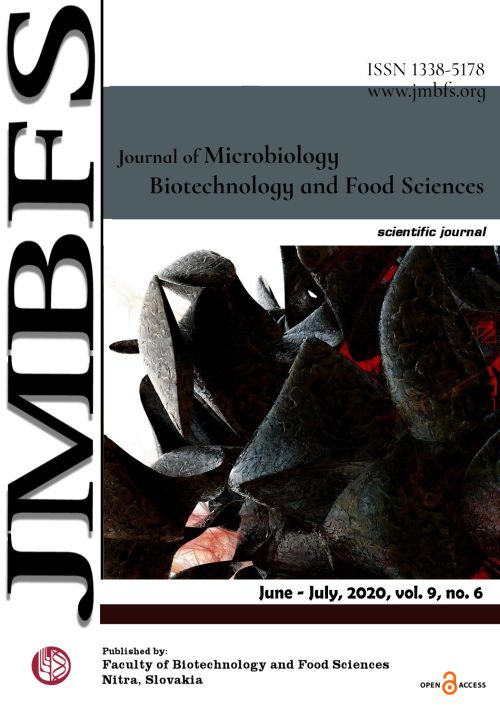HEAT AND pH STABLE PROTEASE PRODUCED BY A BACTERIUM ISOLATED FROM FIELDS WITH HIGH BORON
DOI:
https://doi.org/10.15414/jmbfs.2020.9.6.1047-1052Keywords:
Protease, boron-tolerant, characterizationAbstract
In this study, production, optimization and characterization of protease produced by a bacterium isolated from Kırka boron mine distinct were performed. The proteolytic activities of isolates were screened based on Anson method. The optimal production conditions for protease were determined by using Central Composite Design. Bacillus sp. DB14 isolate (accession number: KY110868) exhibited the highest activity in terms of protease enzyme (346.15 U/mg) among the other isolates screened. The highest result for protease activity of Bacillus sp. DB14 isolate was obtained as 481.76 U/mg according to experimental set. Optimum pH and temperature of Bacillus sp. DB14 protease were found as 10.5 and 60 °C, respectively. Interestingly, this enzyme could stand stable at the range of 20-50 °C. However, the enzyme activity started to decrease highly after 50 °C. Besides, pH stability of this enzyme was provided between pH 7 and pH 11. Inhibition of protease was observed in solution with 10 mM Ni2+, Fe3+, Hg2+, Cd2+ and B3+. Cu2+ ion was found to enhance enzyme activity. Bacillus sp. DB14 protease exhibited remarkably stability in the temperature range of 20 °C and 50 °C. Proteolytic activity values obtained at the range of pH 7-11 were stable. These results indicated that the alkaline protease from this isolate might be potential for biotechnological applications.Downloads
Download data is not yet available.
Downloads
Published
2021-03-11
How to Cite
YİĞİT ÅžAT, E. ., YAMAN, B. N. ., GEDÄ°KLÄ°, S. ., ÇELÄ°K, P. A. ., & ÇABUK, A. (2021). HEAT AND pH STABLE PROTEASE PRODUCED BY A BACTERIUM ISOLATED FROM FIELDS WITH HIGH BORON. Journal of Microbiology, Biotechnology and Food Sciences, 9(6), 1047–1052. https://doi.org/10.15414/jmbfs.2020.9.6.1047-1052
Issue
Section
Microbiology
License
Copyright (c) 2020 Esma YİĞİT ŞAT, Belma NURAL YAMAN, Serap GEDİKLİ, Pınar AYTAR ÇELİK, Ahmet ÇABUK

This work is licensed under a Creative Commons Attribution 4.0 International License.
All papers published in the Journal of Microbiology, Biotechnology and Food Sciences are published under a CC-BY licence (CC-BY 4.0). Published materials can be shared (copy and redistribute the material in any medium or format) and adapted (remix, transform, and build upon the material for any purpose, even commercially) with specifying the author(s).





